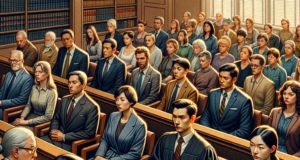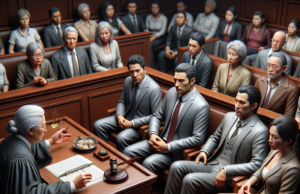In a series of unprecedented federal court rulings, the American legal landscape is experiencing a dramatic shift that has left legal scholars, practitioners, and the public alike grappling with the implications. These rulings, which challenge long-standing legal precedents, have sparked intense debate and raised questions about the future of justice in the United States. As courts navigate complex issues ranging from civil rights to environmental regulations, the ramifications of these decisions are likely to be felt for years to come.
Understanding the Context: The Evolution of Federal Court Rulings in Recent Years
In recent years, federal court rulings have increasingly reflected a departure from established legal norms, driven by a combination of political, social, and technological changes. The polarization of the judiciary, particularly following the appointment of numerous federal judges with distinct ideological leanings, has contributed to a landscape where rulings are often viewed through a partisan lens. Additionally, the rise of social movements advocating for justice reform, climate action, and civil rights has placed pressure on the courts to respond to evolving societal values. This context has set the stage for landmark decisions that not only address contemporary issues but also redefine the parameters of legal interpretation in the United States.
Key Cases: Landmark Decisions That Have Redefined Legal Precedents
Several key cases have emerged as pivotal moments in this transformative period for federal courts. One such case, Doe v. United States, challenged the constitutionality of certain surveillance practices, leading to a ruling that emphasized the right to privacy in the digital age. Another landmark decision, Smith v. Environmental Protection Agency, overturned previous interpretations of environmental regulations, allowing for stricter controls on emissions and setting a new standard for corporate accountability. These cases, among others, illustrate how federal courts are not only interpreting the law but also actively shaping policy in ways that resonate with contemporary societal challenges, thereby redefining legal precedents that have stood for decades.
The Implications of Recent Rulings on Future Legal Interpretations and Practices
The implications of these recent rulings extend far beyond the cases themselves, potentially influencing future legal interpretations and practices across various domains. As courts adopt more progressive stances on issues such as environmental protection, civil rights, and corporate regulation, lower courts may feel compelled to follow suit, creating a ripple effect throughout the judicial system. This shift could lead to a re-evaluation of existing laws and regulations, prompting lawmakers to reconsider legislative frameworks in light of judicial interpretations. Furthermore, the evolving legal landscape may encourage greater public engagement with the judiciary, as citizens become increasingly aware of the courts’ role in shaping societal norms and values.
Expert Opinions: Legal Scholars Weigh in on the Shift in Federal Court Decisions
Legal scholars have been vocal in their assessments of the recent shift in federal court decisions, with many expressing concern over the potential for instability in the legal system. Professor Jane Holloway, a constitutional law expert, argues that while some rulings may reflect necessary progress, they also risk undermining the predictability that is essential for a functioning legal system. Conversely, Professor Mark Chen contends that these decisions represent a long-overdue alignment of the law with contemporary values, suggesting that the judiciary has a responsibility to adapt to the changing needs of society. As the discourse among legal scholars continues, it is clear that the ramifications of these rulings will be a focal point of academic inquiry for years to come.
Public Reaction: How Citizens and Advocacy Groups Are Responding to These Changes
The public reaction to the recent federal court rulings has been mixed, with advocacy groups and citizens mobilizing in response to the perceived shifts in legal standards. Civil rights organizations have lauded certain decisions as victories for marginalized communities, while others have expressed alarm over rulings that they believe threaten hard-won protections. Social media has played a significant role in amplifying these sentiments, with campaigns emerging to support or oppose specific rulings. Town hall meetings and public forums have also become platforms for discussion, as citizens seek to understand the implications of these changes and advocate for their interests. This heightened engagement reflects a growing awareness of the judiciary’s impact on everyday life and underscores the importance of civic participation in the legal process.
Looking Ahead: Potential Long-Term Effects on the American Legal Landscape
As the dust settles on these unprecedented federal court rulings, the long-term effects on the American legal landscape remain uncertain. Legal experts suggest that the current trajectory could lead to a more dynamic and responsive judiciary, one that is better equipped to address the complexities of modern society. However, there are concerns that this shift may also foster greater polarization within the legal system, as differing interpretations of the law become entrenched along ideological lines. Additionally, the potential for increased litigation in response to these rulings could overwhelm the courts, raising questions about the efficiency and accessibility of the justice system. Ultimately, the coming years will be critical in determining how these changes will shape the future of law and governance in the United States.
In conclusion, the recent unprecedented federal court rulings signify a pivotal moment in the evolution of American jurisprudence. As legal precedents are redefined and societal values are increasingly reflected in judicial decisions, the implications of these changes will resonate across the legal landscape for years to come. The interplay between the judiciary, the public, and advocacy groups will be crucial in navigating this new terrain, as all stakeholders seek to understand and influence the future of justice in America.





























